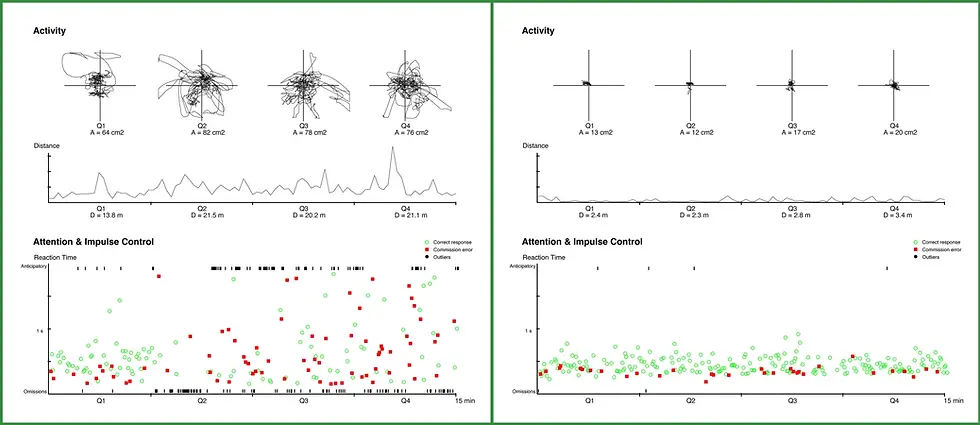Why QbTest is a Game-Changer for Clinicians in ADHD Evaluations
- BELKIS Perez, MSN, AGPCNP-C, AGACNP-BC, PMHNP-BC
- May 28
- 4 min read

Diagnosing Attention Deficit Hyperactivity Disorder (ADHD) has traditionally relied on subjective measures like clinical interviews and rating scales, which, while valuable, can sometimes lead to diagnostic uncertainty. Enter QbTest, an FDA-cleared, objective testing tool that’s transforming how clinicians assess and manage ADHD. By providing precise, data-driven insights into core ADHD symptoms—hyperactivity, impulsivity, and inattention—QbTest empowers clinicians to make faster, more confident, and accurate diagnostic decisions. Here’s why QbTest is becoming an indispensable tool for clinicians.
1. Enhanced Diagnostic Accuracy with Objective Data
Unlike traditional assessments that depend heavily on subjective reports, QbTest offers objective measurements of ADHD symptoms. During a 15–20-minute computer-based task, patients respond to stimuli while an infrared camera tracks their movements with millimeter precision. The test compares the patient’s performance to a normative control group of the same age and sex, providing clinicians with clear, visual reports that highlight deviations in attention, impulsivity, and activity levels.
According to the AQUA study, 94% of clinicians reported a greater understanding of patients’ symptoms when using QbTest, enabling more precise diagnoses, especially in complex cases or subtle presentations, such as in girls or patients with comorbidities. Hollis, C., et al. (2018). Journal of Child Psychology and Psychiatry. Link
Sample QbTest Report:

2. Faster Time to Diagnosis
Time is critical in ADHD evaluations, as delays can impact patients’ access to treatment and support. QbTest streamlines the diagnostic process by reducing the number of appointments needed to reach a decision. The Focus ADHD National Programme evaluation found that QbTest reduced clinical appointments by 11.5% on average, freeing up clinician time and shortening waitlists. In some cases, diagnostic decisions were made up to 44% faster within six months compared to standard assessments alone.
This efficiency is particularly valuable in pediatric settings, where QbTest has been shown to cut down the time from referral to diagnosis, allowing children to access interventions sooner. Hall, S.S., et al. (2024). BMC Health Services Research.
3. Increased Clinician Confidence
QbTest’s detailed reports provide clinicians with objective evidence to support their diagnostic and treatment decisions. The visual nature of the reports makes it easier to identify patterns in symptoms, such as excessive movement or impulsivity, which might be harder to quantify through interviews alone. Clinicians report feeling more confident initiating medication or ruling out ADHD when QbTest data corroborates their clinical judgment.
“QbTest provides clear, objective evidence of ADHD symptoms, down to the millimeter of movement and every click made,” says Dr. Sheila Woods, MD, who has used QbTest since 2012. This confidence is especially crucial when assessing patients with subtle symptoms or when subjective reports from parents, teachers, or patients conflict. Qbtech, www.qbtech.com
4. Improved Communication with Patients and Families
Explaining an ADHD diagnosis or treatment plan can be challenging, especially when patients or families struggle to understand abstract symptoms. QbTest’s intuitive, visual reports bridge this gap by providing a clear, tangible representation of the patient’s performance. Clinicians can walk families through the results, showing how the patient’s symptoms compare to peers, which fosters greater understanding and acceptance of the diagnosis.
The East Midlands Academic Health Science Network noted that most patients found QbTest helpful in understanding their symptoms, particularly when clinicians explained the reports. This transparency enhances patient-centered care and strengthens trust between clinicians and families. Qbtech, www.qbtech.com
5. Effective Treatment Monitoring
Beyond diagnosis, QbTest excels in monitoring treatment efficacy. By conducting follow-up tests, clinicians can objectively measure changes in symptoms, such as improvements in attention or reductions in hyperactivity after starting medication. The test is sensitive to the effects of medications like methylphenidate, with changes detectable as early as one hour post-dose. This allows clinicians to fine-tune treatment plans with precision, ensuring optimal outcomes.
A study by Martin-Key et al. (2022) highlighted QbTest’s ability to capture treatment responses not always reflected by rating scales, making it a valuable tool for ongoing ADHD management. Martin-Key, N.A., et al. (2022). Journal of Clinical Psychopharmacology.
6. NICE-Endorsed and Backed by Robust Research
QbTest is the first and only digital technology recommended by the National Institute for Health and Care Excellence (NICE) for assessing ADHD in children and young people aged 6–17. This endorsement, part of NICE’s Diagnostics Assessment Programme (DG60), underscores QbTest’s clinical utility and efficacy, based on over 40 peer-reviewed studies and 20 years of research. Trusted by over 10,000 clinicians across 13 countries, QbTest meets high regulatory standards, including FDA clearance and ISO certifications, ensuring reliability and safety.
By integrating QbTest into their practice, clinicians align with evidence-based, gold-standard care, enhancing both credibility and patient outcomes. Qbtech, www.qbtech.com
7. Flexible and Easy to Integrate
QbTest is designed to fit seamlessly into existing ADHD care pathways. It can be administered in-clinic or remotely via QbCheck, a web-based version, offering flexibility for both clinicians and patients. The test takes only 15–20 minutes and can be overseen by a trained healthcare assistant, minimizing the impact on clinicians’ schedules. Qbtech’s team of clinical advisors provides support for installation, training, and report interpretation, ensuring smooth adoption.
The Focus ADHD National Evaluation reported positive feedback from healthcare staff on QbTest’s ease of use and integration, particularly in pediatric services. Hall, S.S., et al. (2024). BMC Health Services Research.
Conclusion: A Tool for Better ADHD Care
For clinicians, QbTest is more than just a diagnostic tool—it’s a pathway to more efficient, accurate, and patient-centered ADHD care. By combining objective data with clinical expertise, QbTest reduces diagnostic delays, boosts confidence, and enhances communication with patients and families. Its ability to monitor treatment effects and its endorsement by NICE make it a standout choice for modern ADHD assessments.
Ready to streamline your ADHD evaluations? Contact us to learn how QbTest can transform your practice and improve outcomes for your patients.






Comments